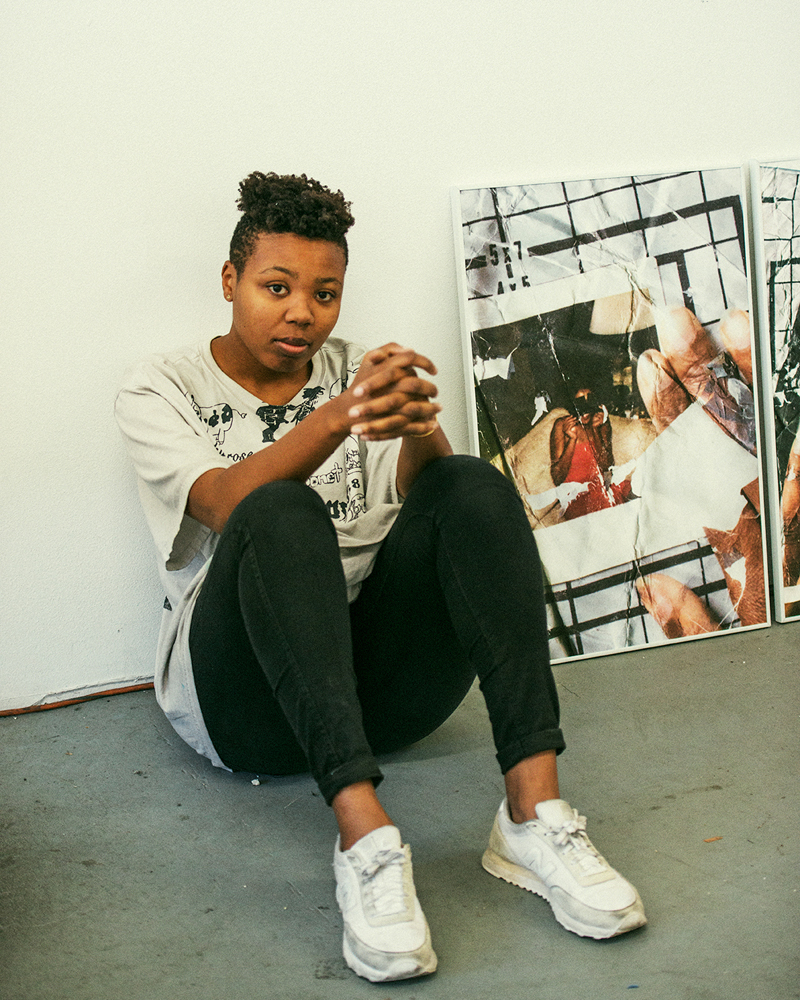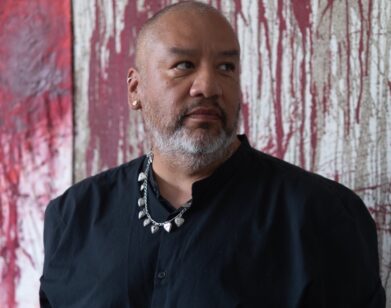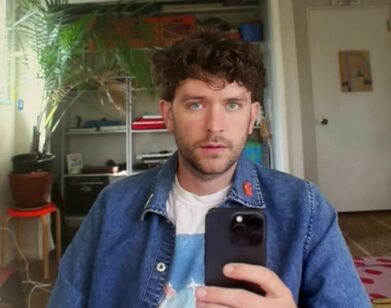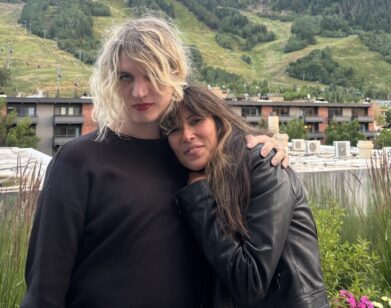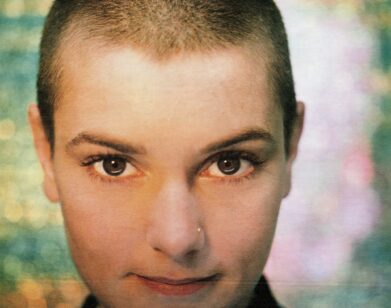The Conceptual Entrepreneur
MARTINE SYMS IN LOS ANGELES, NOVEMBER 2015. PORTRAITS: BRIAN HIGBEE.
The first time we spoke to Martine Syms in 2009, she was a recent graduate of the School of the Art Institute of Chicago and still living in the same city alongside artist Marco Braunschweiler. Together they ran Golden Age, a carefully curated boutique, bookstore, and event space, until it closed in 2011. Since that conversation, Syms has founded the publishing imprint Dominica, returned to her childhood home of Los Angeles, and established a name for herself within various art communities through written and printed works, videos, and lectures (she also does branding and web design). Her written texts, which have appeared in various publications, such as Art in America and Triple Canopy, explore and analyze cultural phenomenon through the creation of fictional worlds, though often spurred by autobiographical information. Syms’ videos and images tackle similar subject matters, but almost always feature her own voice or appearance in conjunction with only one other performer and found footage. Above all else, however, her work—no matter the form—nearly always returns to one thing: television, specifically the sitcom.
For the New Museum’s 2015 Triennial earlier this year, Syms created a large-scale installation, S1:E1, with A Pilot for a Show About Nowhere serving as it’s centerpiece. The 25-minute long video gives a pastiched history of African Americans’ depictions in television through Syms’ imagined sitcom, She Mad. It highlights the comedic strengths and deficiencies of sitcoms like The Cosby Show (why was there no mention of crack cocaine or the AIDS crisis?). This fall and winter, the 27-year-old presented a solo show at Bridget Donahue in New York (fusing gesture with video, text, and nightclub-like lighting) and debuted a poster-based series for Locus Projects during Art Basel Miami Beach.” She also just finished her first documentary.
Now, Syms is working on an ambitious solo show that will open in February at Human Resources, an artist-run space in L.A.’s Chinatown, and is preparing to publish two books via Dominica: one a compilation of performance scripts by British artist Hannah Black; the other a collection of science-fiction poems written by Sara Knox Hunter. In 2007, Syms’ multiple endeavors led to her coining the term “conceptual entrepreneur,” which she has since labeled herself. Though the definition of the term might continuously evolve, this can be certain: Syms is intelligently going to do what she wants, how she wants, and will not slow down any time soon.
EMILY MCDERMOTT: Can you tell me about your upcoming show at Human Resources?
MARTINE SYMS: It’s going to be a show of videos. I’ve been making 30-second videos for the past year and a half. They were first commissioned by the Walker Art Center in Minneapolis—I gave a talk there about five lessons from the poet Kevin Young’s book [The Grey Album]. In the book, he writes them as the lessons of a tradition, but it felt like there had to be more than five, so I started thinking of more myself. That was the initial impulse. I got it into my head that I was going to make an hour-and-a-half feature length film of all these lessons. Right now I have about 60, but I’m trying to do 180 by February.
MCDERMOTT: You use yourself as a character in many of your videos. At what point did you realize you wanted to not just create art, but insert yourself into it?
SYMS: I guess I’ve always inserted myself with my voice. The piece that was in the Triennial at the New Museum this year, Pilot for a Show About About Nowhere, was the first time I was in it as a performer performing myself, making a version of my life. But everything that I’ve worked on, including the show I had this fall at Bridget Donahue, uses a lot of autobiographical material as the source of the world—building and storytelling.
MCDERMOTT: So you use autobiographical information to form fictional worlds. What is the balance between fiction and the real world within your work?
SYMS: I think I do more fiction than autobiography. My interest in autobiography is more as a kind of a historical research; there’s a great book, Wayne Kostenbaum’s My 1980s [and Other Essays], where he talks about autobiography being an intellectual pursuit. I’ve also been working on a piece for Triple Canopy that is based in the area I grew up, but set in the future. A lot of my research was looking at housing covenants that made me born where I was, when I was. Growing up in a specific area has a certain sociological and economic reason, so I’m interested in using myself as a case study to look as those things. My writing, it’s mostly fiction, but I want it to feel intimate and real.
MCDERMOTT: A lot of your work is humorous as well. Where does the humor come in?
SYMS: I think that’s from watching so many sitcoms my entire life. I just have a deadpan sense of humor, I guess. It’s a tone that I really appreciate and most of the things I’m engaged with are comedic. I think there’s a lot of freedom in the comedic and the absurd. It’s a way you can play or do things that are maybe extreme ways of cutting a heavy handedness. You can really talk about, say, or do anything under the guise of the comedic.
MCDERMOTT: But do you ever feel like using so much comedy then dilutes the previously heavy handed meaning or message?
SYMS: I don’t think it dilutes it because I never want to sound too self-important. It’s more about being in the right tone. It’s not about watering something down or making it easier to swallow; it’s actually more direct, in a way.
MCDERMOTT: I read the piece you wrote for Art Papers about growing up with television in the ’80s and how it’s changed in recent years. So, like you said, TV has a huge influence on your work, but at what point did you recognize its impact?
SYMS: Senior year of art school, every piece I was making was about MTV’s The Real World, so I guess television’s been a pretty constant influence. The work with The Real World was about people in their 20s, or even younger, college age. I realized I was older than the people on the show and that was such a shocking realization. [laughs] I watched it when I was young because it was like, “This is how you’re supposed to be when you’re an adult.”
MCDERMOTT: If everyone was that way when they were an adult we’d be in for an interesting world…
SYMS: [both laugh] Yeah, now you’re like, “Oh my god, that’s a horrible idea.” But then, it was trying to fit into some of those stock characters. Also, with that show, I was really interested in fictionalizing reality. The first piece I made is this seven-minute excerpt that I modified through VHS manipulation. That was a really early piece and it has a lot of the same threads I continue to be interested in. Additionally, I feel like within American culture, TV is such a dominant discursive platform; it is where all of our culture values and anxieties end up being discussed and where the conscious of American culture really resides. There’s a lot of material in thinking through that and our national identity.
MCDERMOTT: Growing up, did you ever act out your own television shows or make home movies?
SYMS: I didn’t really make home movies, but once I was in high school, I was in this arts program at Echo Park Film Center, so I was making films and videos. One was a horror movie about the Unborn Victims of Violence Act. It was like a feminist horror movie. It was all these fetuses attacking people. I made them all, they were very supportive of me. [laughs] I was really into John Waters and George Kuchar and that kind of trash cinema style of moviemaking. I made another Super 8 film that was all about road rage, but it was interpretive road rage, so all the cars were cutouts that my friends were wearing. I was home schooled, so I had some time on my hands…
MCDERMOTT: When did you become aware of the ability to create art through film? Has art always been a part of your life?
SYMS: I would say in middle school I started to think of myself that way. I was never good at drawing. I wasn’t one of those people who was “talented.” I could not draw photo realistically; I could not paint anything. So it was never, “Oh, Martine, she’s good at art.” I would write, though. I was interested in writing, coming up with these stories. I was always really interested in film and wanting to make movies, take polaroids.
MCDERMOTT: Do you remember a specific artist or book that impacted you at that time?
SYMS: I remember seeing a Diane Arbus and [William] Eggleston show in middle school. There was a show at the Getty of that era of photography, the ’60s, and that was really influential to me. I was also really into punk music and the culture surrounding that—making books, reading Please Kill Me, looking at old fanzines. Also, skateboarding. I didn’t skate, but all my friends and my brother did, so I watched skate videos and things like that. Skating videos and watching John Waters movies were more of my sensibility at the time, probably more influential than Eggleston.
Then later, once I started learning more about art, I remember Richard Prince and [John] Baldessari were two of the first artists that I knew in conceptual, more contemporary art, after this introduction through photography. So I was doing a lot of printmaking. That was the first stuff I was really into.
MCDERMOTT: I’m not going to ask you to define “conceptual entrepreneur,” because I know that’s always asked of you and you’ve been using the term for about eight years. But how do you feel about labeling yourself a conceptual entrepreneur now? Do you feel like it’s still appropriate?
SYMS: I’m surprised that it’s been able to last that long. [laughs] I definitely didn’t think I’d still be talking about it. But I think my main interests and ideas have always come from independent music, black-owned businesses, and the idea of self-determination through having a sustainable institution, through institutionalizing yourself. Now I’m more aware of the problems and theoretical issues with that. And obviously, with the tech industry, where entrepreneur has kind of a horrible air surrounding it, I’m definitely more conflicted. But I’m still very interested in self-determination and being able to actually survive doing the work I want to do. So it’s important to talk about some of things I’m doing as labor, as work, but I also understand the limitations of that and of using that language. I’m not resolved on it now. But I still do this publishing company, I still definitely am running a small business. So it’s still accurate, but I have more qualms with it.
MCDERMOTT: On another note, purple has been a recurring color in your works since the beginning. What does the color purple mean to you?
SYMS: It’s about this slip in language, the split between object and language. When you see the object or piece, you think, “The color purple,” sort of in reference to the book and the movie as well. I’m really interested in that movie as a cultural product that maybe helped Spielberg the most. But also, Alice Walker, the way she describes the book, she says something like, “Woman is to feminist, what purple is to lavender.” That’s a nice corollary to how I came at it. Really, I just want people to think that phrase and tie it back to the idea of black radical feminism.
MCDERMOTT: Your work moves between object and language all of the time, but what attracted you to that split to begin with? During the lecture you gave at Walker, you said “everything beings with with reading”…
SYMS: For me, it is about reading. There’s a literary element to a lot of my work, but also thinking about images as a thing that can be read, and setting them up to be read. Sometimes it’s [reading in] a very literal way, but with others, like a video, it’s about still having text, where each gesture feels almost like a letter or word and there’s sentences that get constructed. It’s making you read images, in a way, or thinking about the way that I’m reading them.
I’m a very avid consumer of everything—music, film, television, books—but all of those I think of as texts, and my work is a way of thinking through all of the ideas I’m encountering. It’s thinking through another form and reading—I’m using that term broadly, reading, watching, looking, seeing—is maybe the initial message of inquiry. For a long time, the next step was writings; I would write an essay or some kind of story that was not directly in response to readings, but responding to ideas brought up. More recently, I’ve been trying to push this idea that the image operates in the same way, but further. So I’m not writing first, but making images first. I used to use pretty much exclusively found footage, but I’ve moved into producing a lot of images and thinking about what it means if I start that way. It’s the same way [of working] as reading a text and then writing, but what happens if it’s more about me creating images?
MCDERMOTT: What are some of the struggles you’ve faced in the changing of that process?
SYMS: I just finished this documentary and that was one of the biggest productions I’ve done. It was a crew of maybe 10 people, which is small for films, but for me, it’s usually just me and the performer, if there’s another person in it. That made me really conscious of how every step of the process has a visual result. I guess I knew that from jobs I’ve been on, but it’s really different when it’s for my artworks, where every person on set, you see them in the work.
It made me realize the systematic racism of making images, too. I learned that the default in film production is a white guy working on it. Doing color was crazy, thinking about film stocks and making things for black skin. Color, just on a programatic level, kind of freaked me out—every way you make a film look, what darkness represents or what lightness represents. With skin, how to make dark skin look better, the defaults aren’t built that way. In making a film about black aesthetics specifically, it was exploring all of those things. But now that I’ve done it once, I’m excited to make more and really push. There’s this cinematographer, Arthur Jafa—he worked with Julie Dash a lot and he works with Ava DuVernay now and a bunch of other people—he talks a lot about a black visual intonation, shooting at different rates and exposures, and trying to make a different image. That’s an idea I’ve been really interested in, but after working on this film, I’m like, “I understand this in a totally different way.” I guess it’s about an image being a text and thinking about how it can be changed and worked on.
MCDERMOTT: So what are the last things you read and watched that inspired you?
SYMS: [laughs] The last thing that I read is kind of embarrassing. I read Shonda Rhimes’s Year of Yes on the plane this weekend and I’ve been quoting it a lot. I shouldn’t be embarrassed, but it’s not the most intellectual book… And the last thing I watched—I watched The Hunger Games last night, but I was really mad about ending. So I don’t know if that counts. The Assassin, that film was probably the last thing I watched that made me want to shoot something, like shoot an image. The Hunger Games made me want to shoot something in a bad way.
MCDERMOTT: I want to quickly ask about Dominca as well. How do you select the artists and writers that you publish?
SYMS: It’s really driven by things I want to see. With Hannah [Black], I’ve read a lot of her works—she writes a lot for The New Inquiry, Text Der Kunst, and The Guardian—and I’ve seen her videos as well. Then I met her in April, we were both part of Rhizome’s “Seven on Seven.” I was so blown away by the piece that she did, I was like, “I have to do something with her.” So it’s really people I’m excited by, either commissioning them to do a work or somebody mentioning in passing that they have an idea. Sara [Knox Hunter] mentioned that she was writing a short science fiction text, and I was like, “Hey, let’s do a book of those.” This other girl, Diamond Stingily, I did a book project with her two years ago because she had been posting excerpts of her first diary on Facebook and they were so funny to me. I just find and ask people if they’d want to expand on ideas. It’s very laid back, organic, low-key projects—that’s how I want to keep it.
FOR MORE ON MARTINE SYMS, VISIT HER WEBSITE.
For more from the 16 Faces of 2016, click here.

